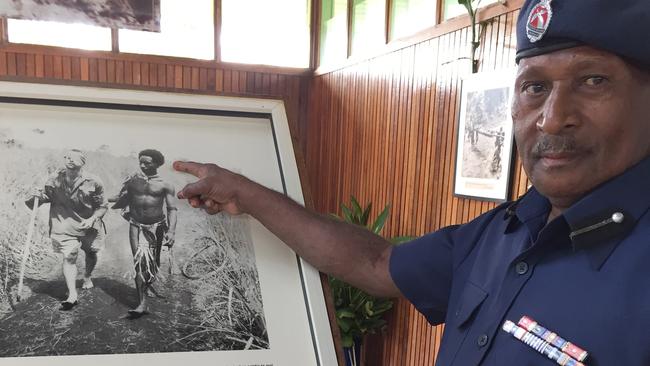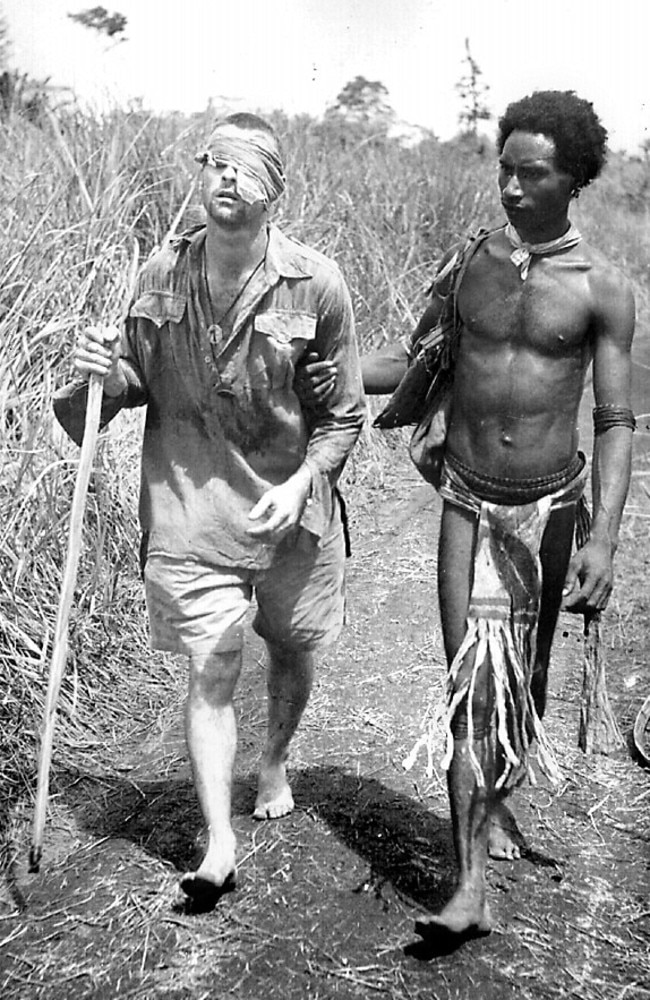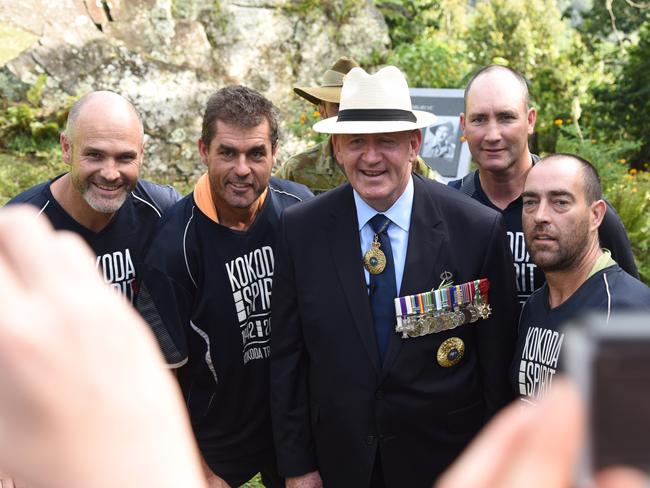The story behind this famous photo of a Fuzzy Wuzzy Angel leading a blind soldier to safety
THIS is the most iconic image of the Kokoda campaign — yet it happened, like so much in war, entirely by chance.

National
Don't miss out on the headlines from National. Followed categories will be added to My News.
EXCLUSIVE
IT is the most iconic image of the Kokoda campaign — yet it happened, like so much in war, entirely by chance.
The story of how this Fuzzy Wuzzy Angel led a blinded Australian soldier to safety was revealed yesterday, during a series of particularly poignant Anzac events in Papua New Guinea filled with reflection, optimism … and even humour.
One of the last surviving Angels — the tribesmen much beloved by the Aussies in their desperate battle against rampaging Japanese forces — almost stole the show when he showed up unexpectedly at the dawn service marking the 75th anniversary of the Kokoda Campaign.
And Australia’s most respected military man, Governor-General and former defence chief Sir Peter Cosgrove, dropped in by helicopter to inspire trekkers retracing our soldiers’ footsteps through the mountains with a blend of oratory and bloke-jokes.
But it is the story of Raphael Oimbari’s rescue of 23-year-old Queensland Private George Whittington, captured on film by famed war photographer George Silk, that really stands out, as descendants of both men shared their stories for the first time.

Oimbari was a labourer, not one of the famed Fuzzy Wuzzy Angel medical porters — in fact Whittington was the first and only Aussie he rescued, after finding him lying blinded in the rough country during fighting around Buna in December 1942.
“He was wounded and lying there in the bush. Raphael came up close, helped him there then took him down the road to an Australian camp,” said his grandson, 62-year-old PNG Chief Inspector Lincoln Enari, yesterday. “I am so sad but proud.”
A Japanese sniper had shot the father-of-one just above the left eye, leaving him temporarily blinded. It was a near thing. Exactly 13 years earlier on Christmas Eve, a cousin had blinded George — known as Charlie by his family — in the right eye as they larked about with an air rifle.
But it never stopped George, who is described as “a real character” by great-niece, Brisbane high school deputy principal Jo Clark.

He cheated in his army medical by memorising the eye test so he passed even with his good eye closed — and he loved playing cricket.
Sister Norma Simmonds, 93, said he was desperate to go to war. “It was sad to see him go but he was determined because his father was badly wounded in the First War.”
And go he did, even sneaking out of hospital without leave during a bout of sickness and attaching himself to another unit, the 2/10 battalion, to make sure he got to PNG.
Although he recovered from his head wound, sadly George succumbed to disease in February 1943.
RELATED: Anzac Day 2017 — Dawn services and marches in Australia and overseas
But the Whittingtons kept in contact with Raphael until he died in 1996. “He was almost one of the family,” said Norma.
Honouring that historic bond between Australians and locals yesterday was one of the last surviving Fuzzy Wuzzy Angels.
Havala Lavla, 91, was an unexpected presence at the dawn service in Port Moresby’s Bomana War Cemetery, turning up in a slouch hat with his grandson and little great-grandson.
He told News Corp: “It is an emotional day for me. A sad day. But I want Australians to come and see the track because of all the people that died.”

When news of his presence at the service filtered round, he was surrounded by wellwishers.
Sir Peter Cosgrove, who took him by the hand to lay a wreath, gave him a Governor-General Medallion as a gesture of thanks.
Later Sir Peter, along with wife Lynne, Opposition Leader Bill Shorten and his wife Chloe and a number of military officials, flew in RAAF helicopters to Kokoda Village and the legendary mountaintop battleground of Isurava, where a small group of soldiers slowed the Japanese tide and first Victoria Cross earned on then-Australian soil was awarded, posthumously, to Melbourne-born Private Bruce Kingsbury for a solo Bren gun charge into the midst of the Japanese that routed them but cost his own life.
He told a rapt audience of trekkers: “By being here you continue their story — our history,” he said, standing in front of the memorial stones carrying the words: Mateship, Courage, Sacrifice, Endurance.

He paid particular attention to the actions of one man: caused so many casualties and so much chaos that the hard-pressed battalion headquarters was saved. Kingsbury was shot dead and posthumously awarded the Victoria Cross — the first awarded on what was then Australian soil.
Respected military man Sir Peter — former chief of the defence force — said the actions of Kingsbury, despite his death, would have inspired his mates massively. And had the 39th not made a stand, things could have been very different.
“The last organised resistance on the Track would have been smashed and the Japanese would have been able to march on,” Sir Peter said.
His words captivated the trekkers who flocked round for photos with their star visitor.
Mud-spattered and shower-deprived, one group was highly amused when he quipped from the middle of their huddle: “If I wasn’t the Governor-General, I’d say you were on the nose.”
Then it was off with the entourage of three choppers, one carrying Opposition Leader Bill Shorten and his wife, heading to Kokoda Village and airstrip — another key battleground in the Kokoda Campaign of 75 years ago.

Originally published as The story behind this famous photo of a Fuzzy Wuzzy Angel leading a blind soldier to safety


